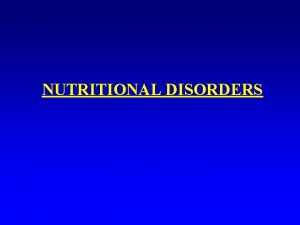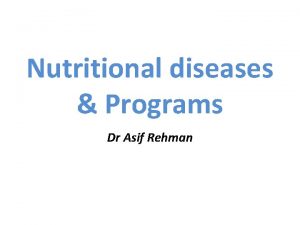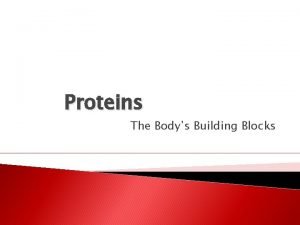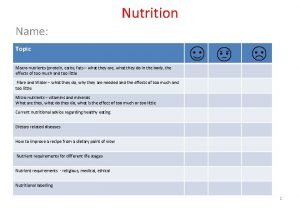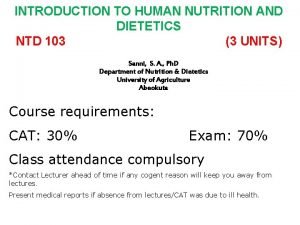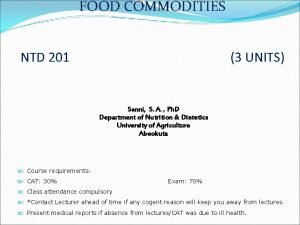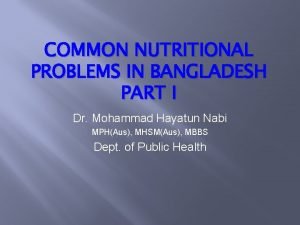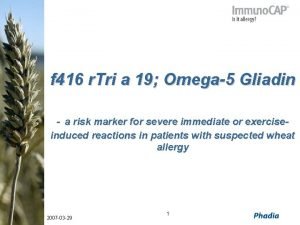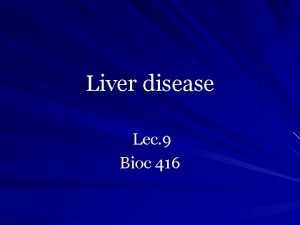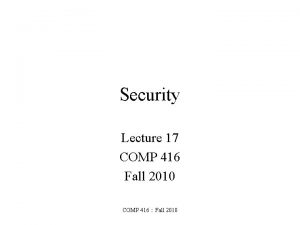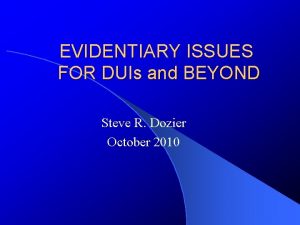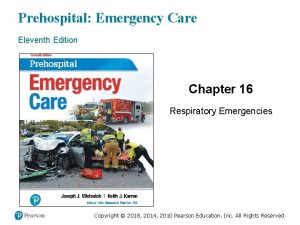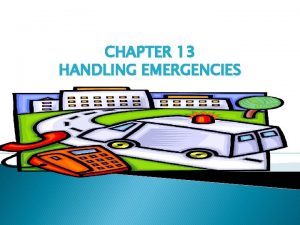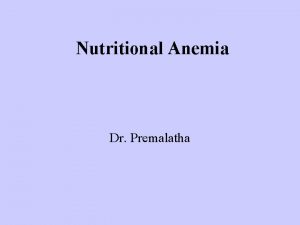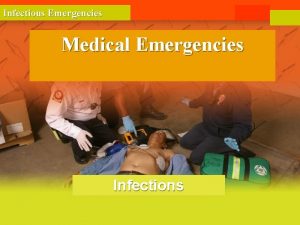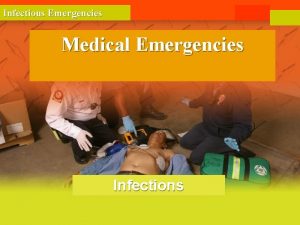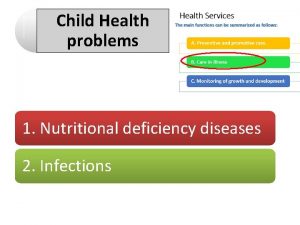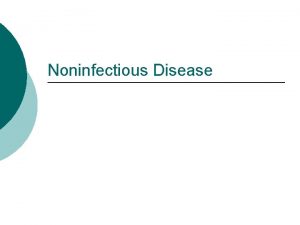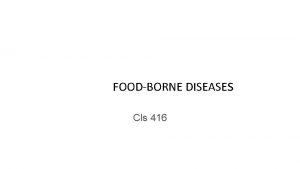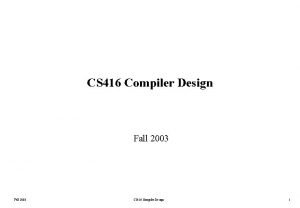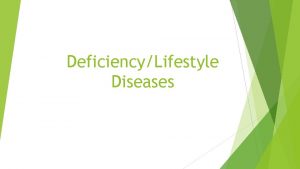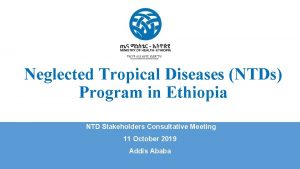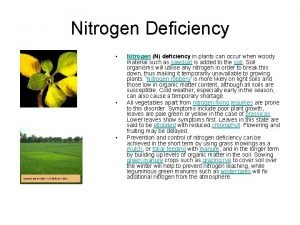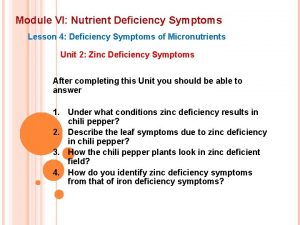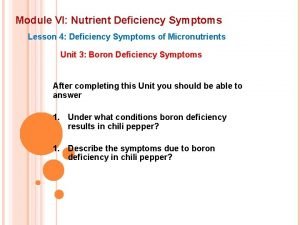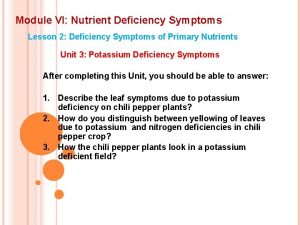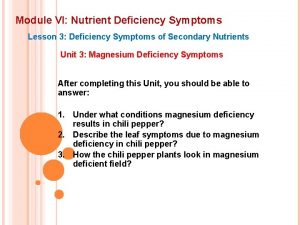MAJOR NUTRITIONAL DEFICIENCY DISEASES IN EMERGENCIES NTD 416






















- Slides: 22

MAJOR NUTRITIONAL DEFICIENCY DISEASES IN EMERGENCIES NTD 416 Mrs J. Y Talabi

INTRODUCTION • Access to food and adequate nutrition is critical to survival in an emergency situation. • A nutrition emergency exists when there is risk of or an actual rise in mortality due to acute malnutrition. • Malnutrition can be the most serious public health problem in an emergency.

• Malnutrition is a pathological condition which arises from the consumption of meals containing excess or inadequate essential nutrients necessary for survival, growth, well being as well as productivity at work thus causing the person to come down with health problems. • The necessary nutrients may involve calories, proteins, carbohydrates, vitamin or minerals.

• When one speaks of malnutrition during a food and nutrition emergency, people are generally referring to rates of wasting/acute malnutrition and severe malnutrition. • However, malnutrition during an emergency encompasses micronutrient deficiencies and stunting/chronic malnutrition. • In a nutrition emergency, the prevalence of acute malnutrition and of severe malnutrition increases significantly. • The prevalence of acute malnutrition, including severe acute malnutrition, can be 10% to 15% among children under five.

• Older children, adolescents, adults and the elderly can also be acutely malnourished, but are less likely to show wasting to the extent that young children do. • Pregnant women are also vulnerable to acute malnutrition. Maternal underweight is a risk factor for low birth weight and increases the risks of maternal mortality. • The term malnutrition refers to the consequences of a combination of inadequate dietary intake and disease as shown in Figure below • The consequences of inadequate dietary intake and disease are particularly pronounced during periods of rapid growth under the age of five.

Causes of Malnutrition

Measuring malnutrition indicator A. Some common anthropometric measurements include: • Height or length • Weight • Mid-upper arm circumference (MUAC) • Skin fold thickness • Head circumference • Height (or length) and weight are the most common anthropometric measures used to indicate protein-energy nutritional status in emergencies.

• Measuring malnutrition indicator Cont’d • Among children, malnutrition is manifested by underweight and growth failure: malnourished children are shorter or stunted and thinner or wasted than they should be for their age. • Among adults, acute malnutrition is manifested by underweight. • Child underweight (measured by low weight-for-age) • Stunting(measured by low height-for-age) and wasting (measured by low weight-for-height). • Stunting is an indicator of chronic malnutrition. • Wasting are indicators of acute malnutrition.

Measuring malnutrition indicator Cont’d Index Nutritional Problem Encountered Weight-for-Height Acute malnutrition (wasting) Height-for-age Chronic malnutrition (stunting) Weight-for-age Any protein –energy malnutrition including (underweight)

• • Measuring malnutrition indicator Cont’d Weight-for-height (wasting) is an indicator of acute malnutrition in children from six months to five years of age, as compared to international reference standards and expressed as a z score. Acute malnutrition among children is defined as weight-forheight of less than two standard deviations of the reference population of normally nourished children. There are 2 forms of severe acute malnutrition: Marasmus (severe wasting) is defined as a weight-forheight of less than three standard deviations of the reference population median weight-for-height Clinical signs of marasmus : Extreme wasting, little fat or muscle, child's skeleton clearly visible, lack of appetite in complicated cases.

MARASMUS: SEVERE WASTING OF BODY FAT AND MUSCLE

• Kwashiorkor is the second form of severe acute malnutrition. It is defined by the presence of oedema of the both feet. Children who have kwashiorkor may not appear underweight initially because of their oedema. • Clinical signs of kwashiorkor are : oedema of both feet; thin, sparse and pale hair that falls out easily, dry scaly skin especially on the arms and legs, a puffy or moon face, apathy. • Height-for-age z score (stunting) is an indicator of chronic malnutrition. • Child underweight (measured by low weight-for-age) is a combination of stunting (measured by low heightfor-age) and wasting (measured by low weight-forheight).

Measuring malnutrition indicator cont’d • B. Body mass index in adults (BMI) is used for measuring acute malnutrition in adults. An adult BMI less than sixteen indicates severe wasting. • One divides weight by height in kilograms by the square of height in meters to get BMI Type and level of malnutrition BMI range Obese 30. 0+ Overweight 25. 0 -29. 9 Normal 18. 0 -24. 9 Chronic Energy Deficiency Mild 17. 0 -18. 4 Chronic Energy Deficiency Moderate 16. 0 -16. 9 Chronic Energy Deficiency Severe <16. 0

Measuring malnutrition indicator contd Ø C. Oedema is fluid collection in the tissue. In some severely malnourished people, fluid leaks out of the blood vessels into the tissues causing a particular kind of swelling, called pitting oedema. • Examination for pitting oedema consists of applying pressure with the thumb to the back of the foot or front of the lower leg for 3 seconds, then releasing. If a dent is seen or felt, pitting oedema is present. • The examiner must press for at least 3 seconds and clearly see or feel a dent remaining after the pressure is released. • Pitting oedema must be present on BOTH feet to be caused by malnutrition. There are many other

Some Effects of Malnutrition on Health and Economic status In infants and young children In adults and women of childbearing age Diminishes the ability to fight infection Increases the risk of complications during pregnancy Impairs growth Increases the risk of spontaneous abortions, still births, impaired foetal brain development and infant deaths Hinders cognitive and mental development thereby reduces learning capacity Reduces work productivity and increases the risk for some kinds of infections including HIV and reproductive tract infection Heightens apathy and fatigue Increases the chances of producing a low birth weigh Increases the chaance of infant and young child mortality Increases the risk of death from miscarriages, stress of labour and other delivery complications

• • Nutrition screening tools for malnutrition Mid-Upper-Arm Circumference (MUAC), which measures fat and muscle in the mid-upper arm, is sometimes used for rapid assessments and screening for malnutrition. MUAC of the left arm should be measured. For children, a cut-off value of <12. 5 cm should be used for children under five to indicate acute malnutrition and any value less than 11. 0 cm indicate severe acute malnutrition. For pregnant and breastfeeding mothers, the cut-off value is 22 cm. Measurement of Mid-Upper-Arm Circumference is prone to measurement error and inaccurate assessment of nutritional status and therefore it is not

• • • Other various nutrition screening tools for malnutrition include Malnutrition Universal Screening Tool (MUST) Nutritional Risk Screening – 2002 (NRS-2002) Mini-Nutritional Assessment (MNA) Short Nutritional Assessment Questionnaire (SNAQ) Malnutrition Screening Tool (MST)

Micro-nutrient Deficiencies Ø There are several indicators for micronutrient deficiencies. Some indicators are clinical, that is, people with a certain deficiency may show signs or symptoms. • Examining a group of individuals in a population for signs or asking them about symptoms which are characteristic of a specific micronutrient deficiency is one way of measuring how common that deficiency is in the population. • The table below lists some clinical indicators for the three major micronutrients

Clinical Indicator Micronutrient Deficiencies Pallor of palms or inside of eyelids or mouth Iron deficiency anaemia Night blindness Vitamin A deficiency Bitot’s spots (Spots on white of eyes Vitamin A deficiency Goitre (Enlargement of thyroid gland) Iodine deficiency

Micro-nutrient Deficiencies-CONTD • Iron deficiency anaemia is the most widespread nutritional problem in the world. • Iron deficiency is the main cause of anaemia; malaria, hookworm, schistosomiasis, other vitamin deficiencies such as vitamin B 12, folic acid and vitamin A and medical conditions such as thalassaemia and sickle cell anaemia which might also contribute to anaemia in a population.

• • Micro-nutrient Deficiencies-Contd Anaemia is diagnosed by low haemoglobin concentration levels or pallor of the skin and inner eyelids. Iron deficiency increases maternal and infant mortality, impairs cognitive development and learning and decreases physical work capacity. Young children and women of reproductive age are especially vulnerable. Diets that are high in grains and low in meat are generally low in iron because the bioavailability of iron in grains and plant foods as well as eggs and dairy products (nonhaeme iron) is much lower than the bio-availability in meat (haeme iron).

D. Micro-nutrient Deficiencies-Clinical Indicators • The bioavailability of nonhaeme iron is increased by consuming foods containing haeme iron as well as fruits and vegetables rich in vitamin C and beer especially because it is fermented. • Other foods that decrease the bio-availability of nonhaeme iron include tea, coffee, nuts, beans and maize.
 Major nutritional deficiency diseases in emergencies
Major nutritional deficiency diseases in emergencies Nutritional diseases
Nutritional diseases Hyperglyceremia
Hyperglyceremia Nutritional diseases
Nutritional diseases Protein deficiency diseases
Protein deficiency diseases Minerals sources functions and deficiency chart
Minerals sources functions and deficiency chart Prepare chart for vitamins and minerals
Prepare chart for vitamins and minerals Ntd 201
Ntd 201 Common nutritional disorder in bangladesh
Common nutritional disorder in bangladesh Tri a 19 omega-5 gliadin
Tri a 19 omega-5 gliadin Tram 2 paris
Tram 2 paris 416 lec
416 lec Comp416
Comp416 Gezang 250
Gezang 250 Tca 55-9-402
Tca 55-9-402 Opwekking 416
Opwekking 416 Math 416 equivalent
Math 416 equivalent Nlb 416
Nlb 416 La 416
La 416 Chapter 19 endocrine and hematologic emergencies
Chapter 19 endocrine and hematologic emergencies A 41 year old man presents with slow irregular breathing
A 41 year old man presents with slow irregular breathing Chapter 16 respiratory emergencies
Chapter 16 respiratory emergencies Chapter 13 handling emergencies
Chapter 13 handling emergencies


